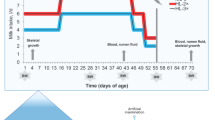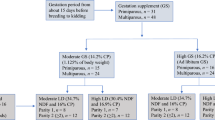Abstract
ARTIFICIAL feeding of lambs is not practised in Egypt, owing to the breeders' belief that lambs do not survive unless they suckle their mothers for at least three to four months. The present study was undertaken to investigate the real effect of such practice with both Awsemy and Rahmany breeds.
This is a preview of subscription content, access via your institution
Access options
Subscribe to this journal
Receive 51 print issues and online access
$199.00 per year
only $3.90 per issue
Buy this article
- Purchase on Springer Link
- Instant access to full article PDF
Prices may be subject to local taxes which are calculated during checkout
Similar content being viewed by others
References
Fisher, R. A., “Statistical Methods for Research Workers” (1936).
Sirry, I., El-Sokkary, A. M., and Hassan, H. A. (to be published).
Author information
Authors and Affiliations
Rights and permissions
About this article
Cite this article
SIRRY, I., EL-SOKKARY, A. Growth of Egyptian Lambs: Effect of Artificial Feeding and Breed Differences. Nature 165, 490–491 (1950). https://doi.org/10.1038/165490b0
Issue Date:
DOI: https://doi.org/10.1038/165490b0
Comments
By submitting a comment you agree to abide by our Terms and Community Guidelines. If you find something abusive or that does not comply with our terms or guidelines please flag it as inappropriate.



